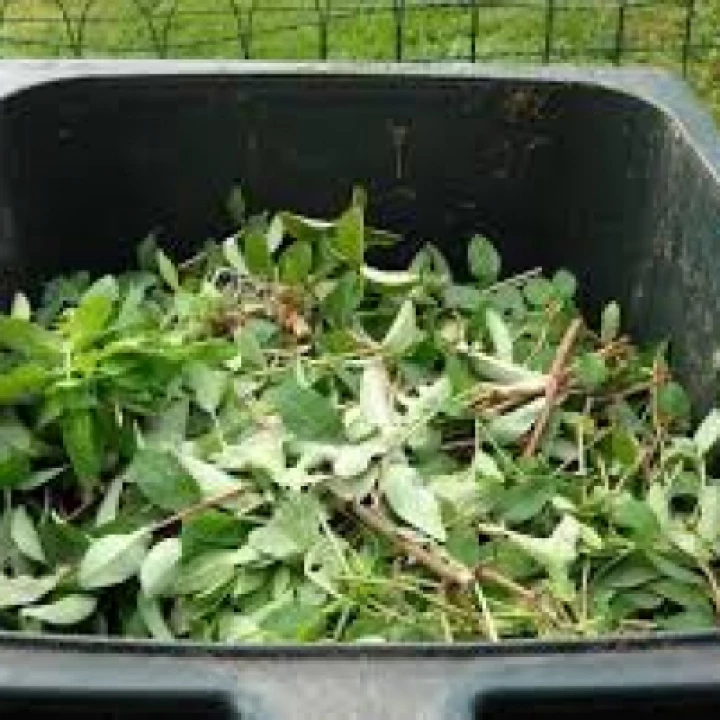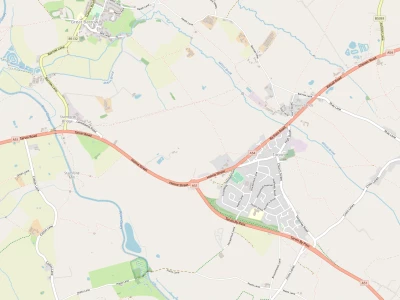English Yew (Taxus baccata)
Our "Grogan Yews."
Standing near to the Hockenhull Lane entrance to the woodland – on the school/Broomheath Lane side – our two large yew trees are an imposing sight. The larger one (the one furthest from the pathway) is presently covered with red berries, which, if hungry birds allow them to remain until Christmas, will make the tree appear very festive. The two trees appear to have been there for years and years, whereas in reality they are both relatively new plantings. The larger one is "Ben", while the smaller – and closer to the pathway – is "Jim".
Our founder, Jim Grogan lost his father in the Second World War and the person to whom he most looked up to while growing up was his elder brother, Ben Grogan. Upon Ben's death, Jim decided that he wished to commemorate both Ben's life and the very significant contribution that Ben had made to the early development of the woodland, and so Jim planted a fine yew tree in his honour. Soon after Jim's death, Sheila, Kevan and Helen Grogan planted another young yew tree, next to that of Jim's brother. This is why we now have the two "Grogan Yews" growing in the middle of the woodland – a really good place for them to be.
The yew tree is one of Britain's native trees held to be particularly sacred by the Druids in pre-Christian times. They no doubt observed the tree's qualities of longevity and regeneration (drooping branches of old yew trees can root and form new trunks where they touch the ground), and the yew came to symbolise death and resurrection in Celtic culture. The Celts will also have been very familiar with the toxicity of the tree's needles in particular (ingestion of which can prove fatal) and which may have further contributed to its connections with death. The themes of death and resurrection continued into the Christian era, with the custom of yew shoots being buried with the deceased, and boughs of yew being used as 'Palms' in church at Easter. Yew trees have in fact established a popular association with old churches in Britain, to the extent that it is difficult to find very old specimens of yew trees anywhere other than on church grounds. According to Richard Mabey in his Flora Britannica "... no other type of ancient tree occurs so frequently inside church grounds ..." and he goes on to say that he does not know of any similarly exclusive relationship between places of worship and a single tree species existing anywhere else in the Western world. In some cases yew trees have been traditionally planted beside churches. As a tree to commemorate good lives well lived, the choice of yew in our woodland seems to be singularly appropriate! In recent years Yew Jim has been used by Tarvin Community Woodland as its Christmas tree.
Yews are normally either male or female and, during autumn and winter, the sexing of yew trees is generally easy. Males have small spherical structures that ultimately will release clouds of pollen when they mature in early spring, while females hold bright red berries from autumn into winter. When, in the spring, male yews bloom, they release abundant amounts of pollen, which makes them extremely allergenic, with a plant allergy scale rating of 10 out of 10. Completely female yew trees, however, trap pollen while producing none of their own and so have a rating of only 1!
The female seed cones contain a single seed, partly surrounded by a fleshy scale which develops into a soft, bright red berry-like structure, which is called an aril. The aril seems to wrap around the seed, while being open at the end. The arils mature 6 to 9 months after pollination has occurred in the early spring and maturation of the arils will then be spread over 2 to 3 months, in order to increase the chances of successful seed dispersal. The fleshy aril, with its seed contained, is a favourite food of thrushes, waxwings and other birds, which disperse the hard seeds undamaged in their droppings. The seeds themselves are poisonous and bitter, but, none-the-less, are opened and eaten by some (evidently resistant) bird species including hawfinches, greenfinches and great tits.
Gelatinous and very sweet tasting, the aril is the only part of a yew tree that is not poisonous to humans. The rest of the yew tree is highly toxic due to the presence of a group of chemicals called alkaloids, with the seeds containing the highest concentrations of these alkaloids. If any seeds or leaves of the plant are ingested, urgent medical advice is recommended. Yew poisonings are relatively common in both domestic and wild animals which might accidentally consume the plant, resulting in a great many fatalities in livestock. It has been suggested that, for a community that wished to grow yew trees – the wood of which is supremely suitable for the production of long bows – they would be well-advised to grow them away from their livestock in the only walled area that existed within the parish, which would be the church yard.
Quick Links
Get In Touch
TarvinOnline is powered by our active community.
Please send us your news and views.










